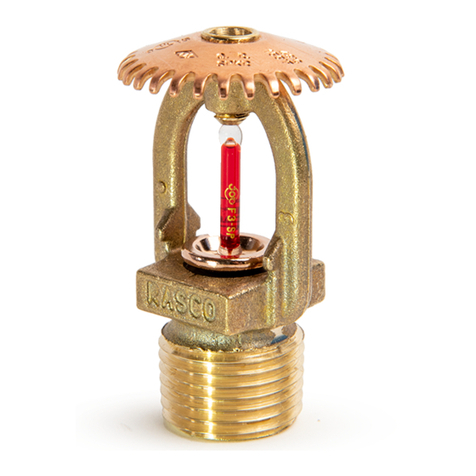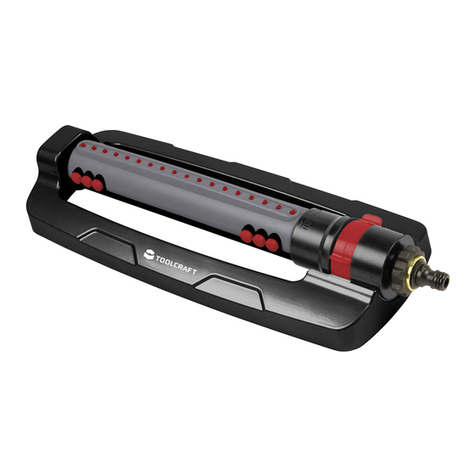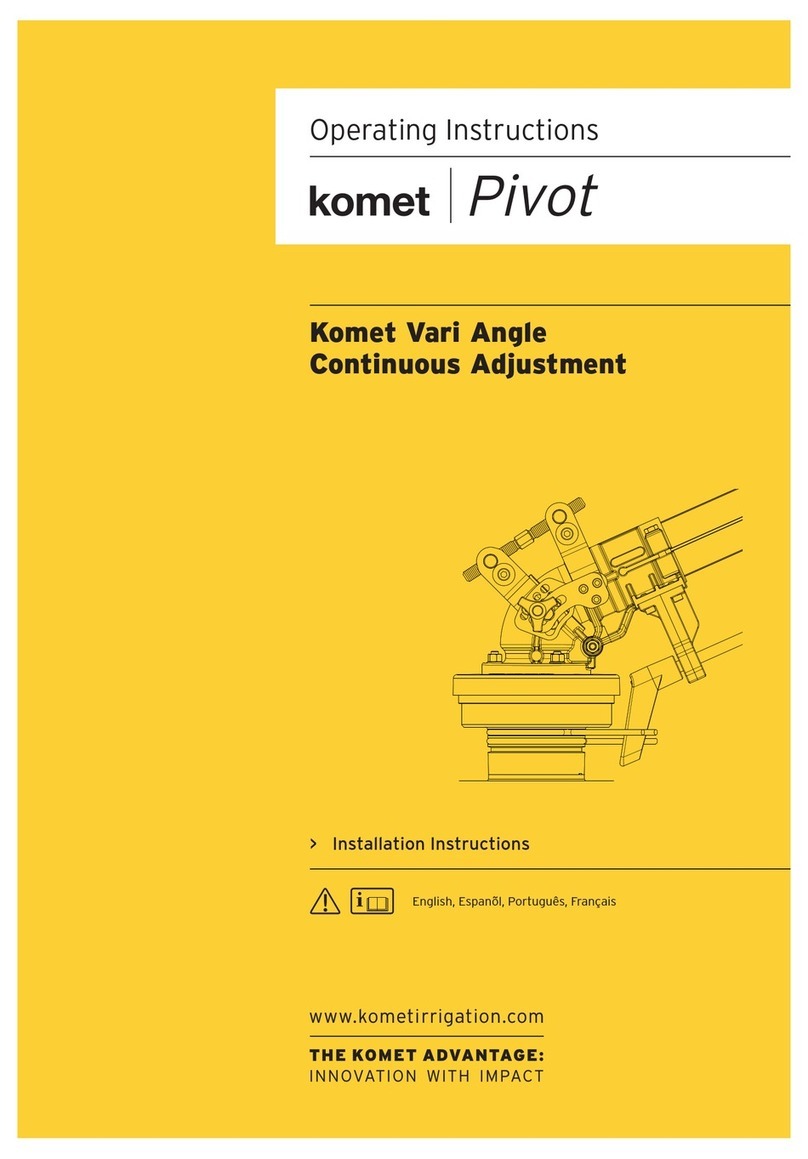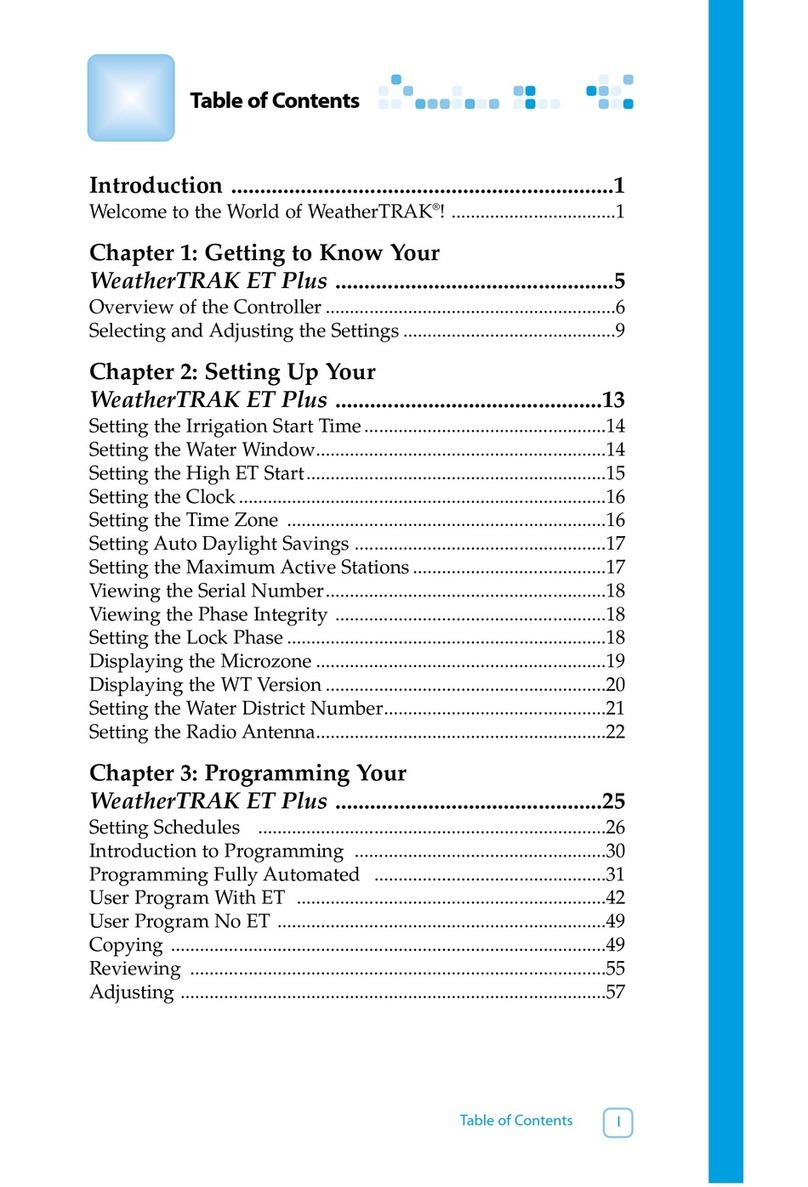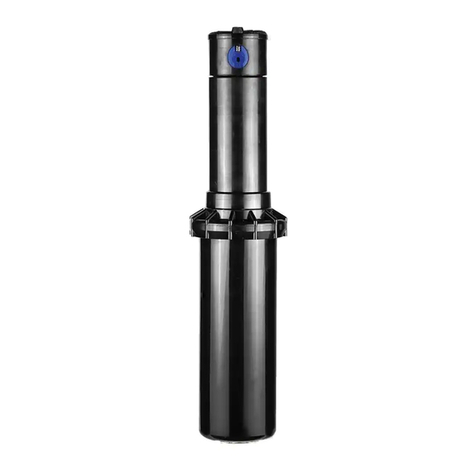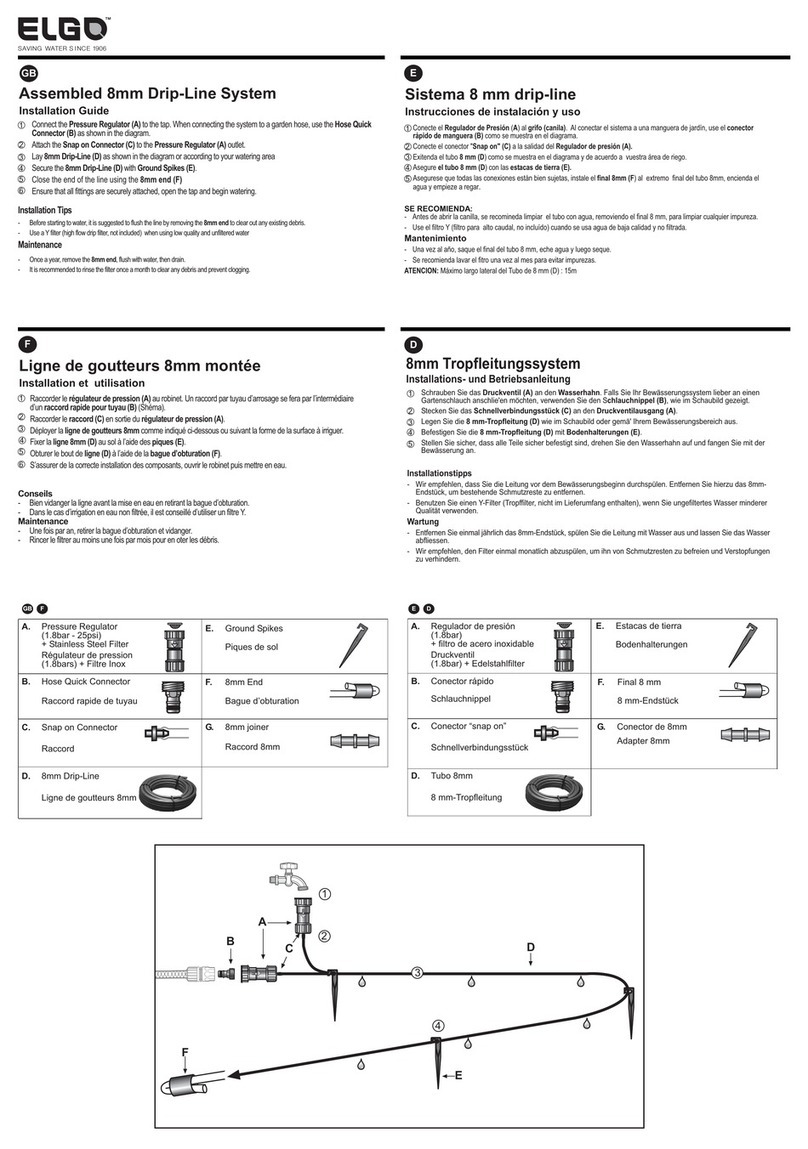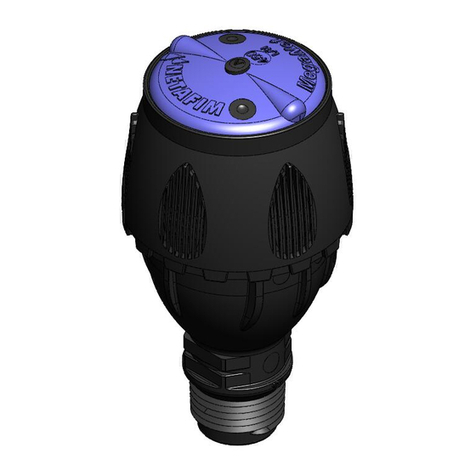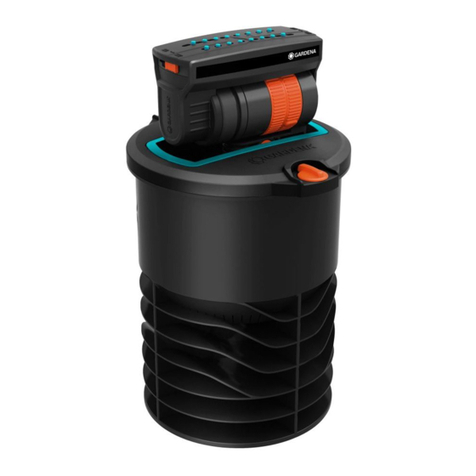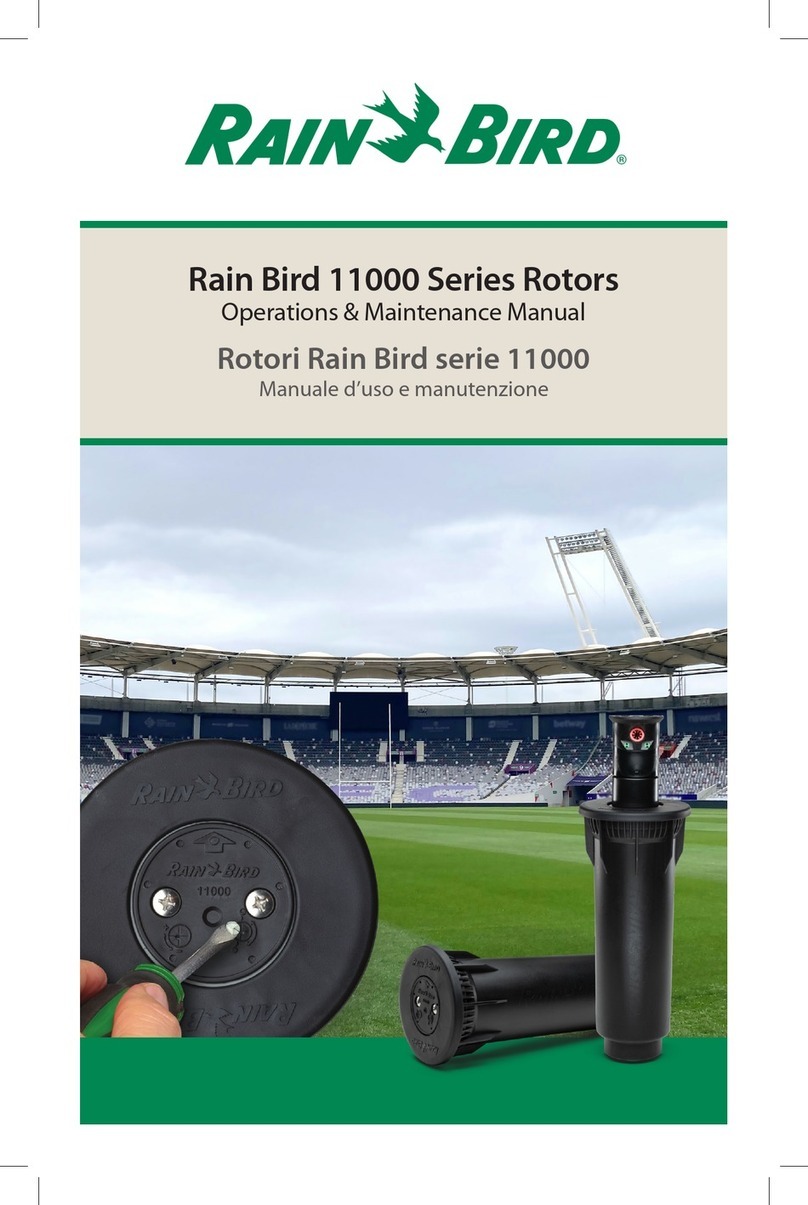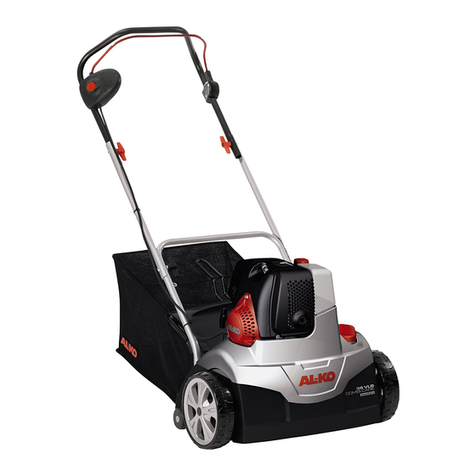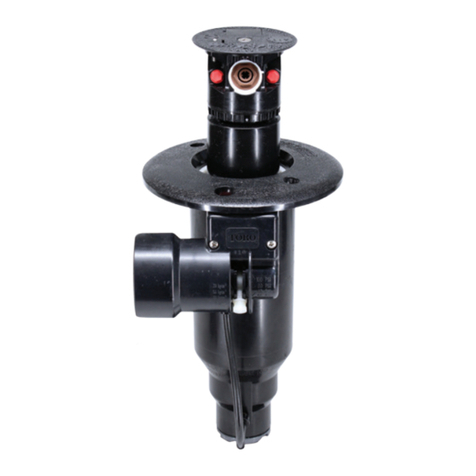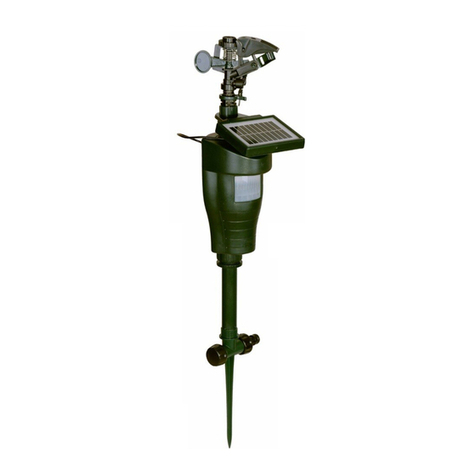CPF SKR15 Maintenance manual

SPRINKLER
ISTRUZIONI INSTALLAZIONE E MANUTENZIONE
INSTALLATION CARE AND MAINTENANCE
REQUIREMENTS
CPF Industriale Srl Via E.Fermi, 98 25064 Gussago Bs) Tel.030 310461 - Fax 030 310465 - e-mail: info@cpfindustriale.it - uff.tec@cpfindustriale.it Ist.9521215027 ed 05 Pag.1 di 8
1. DESCRIZIONE GENERALE
DESCRIZIONE GENERALE
SPRINKLER 1/2” SKR15
PRODUCT DESCRIPTION
Lo sprinkler è un dispositivo per l’estinzione e la limitazione degli
incendi.CPF Industriale Srl. produce sprinkler con attacco da 1/2” e
3/4” nelle versioni Upright e Pendent, sia con bulbi G5 sia con bulbi
F3. Gli sprinkler upright e pendent della CPF Industriale sono marcati
CE 0099, in quanto certificati in conformità con il regolamento
2011/305/UE alla norma UNI EN 12259-1
Sprinkler is a device to extinguish and limit the fire. CPF Industriale
Srl produces sprinkler with 1/2” and 3/4” connections models Upright
and Pendent,
with G5 and F3 glass bulb. CPF Industriale sprinkler upright and
pendent models are marked CE 0099, as they are approved in
accordino to 2011/305/EU regulation and UNI EN 12259-1 norm.
0099
PENDENT
L: 51 mm
W: 27 mm
Peso/Weight: 70 gr
0099
UPRIGHT
L: 51 mm
W: 35 mm
Peso/Weight: 77 gr
W
L
Filetto: 1/2"
Coppia di serraggio: 40 Nm
Misura foro: 15 mm
Finitura standard:ottone naturale/cromato
Altre finiture: cromo, verniciato bianco, verniciato nero
Fattore-K: 5.6 Unità inglese) 80 Unità SI)
Pressione massima: 175 psi 1207 KPA)
Pressione minima: 5 psi 35 KPA)
Tempi risposta RTI)G5: 105 ms)½,190 fts)½
Tempi risposta RTI) F3: 36 ms)½, 65 fts)½
DATI TECNICI TECHNICAL DATA
Thread: 1/2”
Torque: 40 Nm
Orifice sise: 15 mm
Standard finish: natural brass/chrome
Other finishes: chrome, painted white, painted black
K-Factor: 5.6 English unit) 80 SI Unit)
Maximum Working Pressure:175 psi 1207 KPA)
Minimum Operative Pressure:5 psi 35 KPA)
Response Time RTI)G5: 105 ms)½,190 fts)½
Response Time RTI) F3: 36 ms)½, 65 fts)½
SPRINKLER 3/4” SKR20
0099
PENDENT
L: 51 mm
W: 27 mm
Peso/Weight: 80 gr
0099
UPRIGHT
L: 51 mm
W: 35 mm
Peso/Weight: 87 gr
W
L
Filetto: 3/4”
Coppia di serraggio: 40 Nm
Misura foro: 20 mm
Finitura standard : ottone naturale/cromato
Altre finiture: cromo, verniciato bianco, verniciato nero
Fattore-K: 8.0 Unità inglese) 115 Unità SI)
Pressione massima: 175 psi 1207 KPA)
Pressione minima: 5 psi 35 KPA)
Tempi risposta RTI)G5: 105 ms)½,190 fts)½
Tempi risposta RTI) F3: 36 ms)½, 65 fts)½
DATI TECNICI TECHNICAL DATA
Thread: 3/4”
Torque: 40 Nm
Orifice sise: 20 mm
Standard finish: natural brass/chrome
Other finishes: chrome, painted white, painted black
K-Factor: 8.0 English unit) 115 SI Unit)
Maximum Working Pressure: 175 psi 1207 KPA)
Minimum Operative Pressure:5 psi 35 KPA)
Response Time RTI)G5: 105 ms)½,190 fts)½
Response Time RTI) F3: 36 ms)½, 65 fts)½

SPRINKLER
ISTRUZIONI INSTALLAZIONE E MANUTENZIONE
INSTALLATION CARE AND MAINTENANCE
REQUIREMENTS
CPF Industriale Srl Via E.Fermi, 98 25064 Gussago Bs) Tel.030 310461 - Fax 030 310465 - e-mail: info@cpfindustriale.it - uff.tec@cpfindustriale.it Ist.9521215027 ed 05 Pag.2 di 8
WATER DISTRIBUTION
Pressure
Bar
Real Press
Bar
Discharge
l/min K Factor
0,69 0,71 68,5 80,35
1,38 1,38 96,9 81,35
2,07 2,07 114 77,8
2,76 2,78 137 81,35
3,45 3,5 154,4 81,78
4,14 4,13 166,5 81,2
4,83 4,84 180 81,06
5,52 5,54 192 80,64
80,69
K FACTORI DISCHARGE.
LEGENDA COLORI BULBI SPRINKLER BULBS COLOR
I dati riportati nelle tabelle e diagrammi presenti sul presente opuscolo
sono tratti da test realmente effettuati da ente di parte terza
Data showing in the present diagrams are been
deduced from really tests effected by
TIPO
TYPE
TEMPERRATURA
TEMPERATURE
COLORE
COLOR
G5-F3 57°C = 135°F Arancio / Orange
G5-F3 68°C = 155°F Rosso / Red
G5-F3 79°C = 175°F Giallo / Yellow
G5-F3 93°C = 200°F Verde / Green
G5-F3 141°C = 286°F Blu / Blue
G5-F3 182°C = 360°F Malva / MaUVE

SPRINKLER
ISTRUZIONI INSTALLAZIONE E MANUTENZIONE
INSTALLATION CARE AND MAINTENANCE
REQUIREMENTS
CPF Industriale Srl Via E.Fermi, 98 25064 Gussago Bs) Tel.030 310461 - Fax 030 310465 - e-mail: info@cpfindustriale.it - uff.tec@cpfindustriale.it Ist.9521215027 ed 05 Pag.3 di 8
RACCOMANDAZIONI PER GLI INSTALLATORI INSTALLER WARNING
PRECAUZIONI CAUTIONS
LEGGERE LE PRECAUZIONI A SEGUIRE PRIMA DI
MANEGGIARE O INSTALLARE GLI SPRINKLER
READ THE FOLLOWINGS CAUTIONS BEFORE
HANDLING OR INSTALLING SPRINKLERS
l’impiego e/o l’installazione impropria possono arrecare danni permanenti allo sprinkler,
impedirgli di funzionare in maniera corretta durante un incendio, o ancora entrare in
azione prematuramente. fare sempre riferimento alla scheda tecnica dello sprinkler che
deve essere installato. l’applicazione impropria puo’ impedire allo sprinkler di funzionare
correttamente durante un incendio. le precauzioni d’uso devono essere comprese da
tutto lo staff i.e. montatori, progettisti, autorità giurisdizionali, gestori di materiale, ecc.)
coinvolto nell’installazione di sprinkler automatici. prestare attenzione durante
l’installazione e seguire le linee guida di cui sotto per garantire che lo sprinkler funzioni
adeguatamente.
improper handling and/or installation can permanently damage a sprinkler and to
prevent it to operate correctly in a fire situation or cause it to operate prematurely.
always refer to the technical data sheet for the installed sprinkler.
improper application can cause the sprinkler to fail in a fire situation.
caution must be understood by all member of the staff e.g. sprinkler fitters, designers,
authorities having jurisdiction, material handlers, etc..) involved with the installation.
CONSER ARE gli
sprinkler nel loro
imballaggio fino all’uso.
DO leave sprinklers in their
shipping container until they are
installed.
DO NOT pile up sprinklers.NON ammucchiare gli sprinkler
INSTALLARE lo sprinkler
nell’apposito alloggiamento
dopo avere messo in opera
la tubazione.
DO INSTALL sprinklers in
sprinkler fittings after sprinkler
pipe is in place.
DO NOT slide pipe throught
structure with sprinklers in place.
NON ruotare la tubazione nella
relativa struttura con gli
sprinkler inseriti.
A ITARE manualmente gli
sprinkler agendo
delicatamente sugli stessi
DO hand - start sprinklers by
gently handing the sprinkler
DO NOT use improper wrenches
NON usare chiavi inadatte.
INSTALLARE lo sprinkler
utilizzando l’apposita chiave
fornita, attenendosi alle
istruzioni a fianco
DO INSTALL sprinklers
with the
manufacturer’s required
sprinkler
wrench.
CHIA E SPECIALE DI SERRAGGIO PER
INSTALLAZIONE SPRINKLER CPF
CLOSING SPECIAL KEY FOR CPF
SPRINKLER INSTALLATION
ATTENERSI SCRUPOLOSAMENTE ALLE ISTRUZIONI
- Inserire orizzontalmente la chiave facendo attenzione a portare la zona "A"
all'interno della gola dello sprinkler;
- Quando la chiave è perfettamente ancorata avvitare lo sprinkler;
- Rimuovere orizzontalmente la chiave.
CPF NON RISPONDE DI EVENTUALI DANNI O ANOMALIE CAUSATI DA UN
USO IMPROPRIO DELLA CHIAVE O DAL SUO MANCATO UTILIZZO.
FOLLOW CAREFULLY THE INSTRUCTION
- Put horizontally the key and pay attentino to bring the zone “A” inside
the throat of the sprinkler;
- When the key is perfectly fixed, screw the sprinkler;
- remove the key horizontally.
CPF IS NOT LIABLE FOR POSSIBLE DAMAGES OR ANOMALIES CAUSED
FROM AN IMPROPER USE OF THE KEY OR FROM ITS MISSED USE.

SPRINKLER
ISTRUZIONI INSTALLAZIONE E MANUTENZIONE
INSTALLATION CARE AND MAINTENANCE
REQUIREMENTS
CPF Industriale Srl Via E.Fermi, 98 25064 Gussago Bs) Tel.030 310461 - Fax 030 310465 - e-mail: info@cpfindustriale.it - uff.tec@cpfindustriale.it Ist.9521215027 ed 05 Pag.4 di 8
PRESTARE ATTENZIONE DURANTE
L’INSTALLAZIONE E SEGUIRE LE LINEE GUIDA DI
CUI SOTTO PER GARANTIRE CHE LO SPRINKLER
FUNZIONI ADEGUATAMENTE.
CARE MUST BE EXERCISED DURING
INSTALLATION AND THE FOLLOWING GUIDELINES
MUST BE FOLLOWED TO ENSURE THAT THE
SPRINKLER WILL OPERATE PROPERLY.
●Conservare gli sprinkler in maniera adeguata e proteggerli
dall’eccessivo calore. Non conservare gli sprinkler alla luce
solare diretta o in aree soggette a temperature estreme. Il
surriscaldamento danneggia lo sprinkler indebolendo
l’elemento termosensibile e provocando l’attivazione precoce.
●Le scatole degli sprinkler sono appositamente studiate per
proteggere gli stessi durante il trasporto. Non togliere gli
sprinkler dalle scatole per metterli in sacchetti o in secchi
prima dell’installazione, perché è possibile danneggiarli.
Installare gli sprinkler prelevandoli direttamente dalla scatola.
●Non installare sprinkler che mostrano segni di
danneggiamento. Sostituire immediatamente tutti gli sprinkler
danneggiati durante l’installazione.
●Ispezionare gli sprinkler a bulbo in vetro al momento
dell’installazione per assicurarsi che il bulbo contenga liquido.
Un bulbo in vetro che mostri segni di perdite o che non
contiene liquido deve essere gettato via. Non installare
sprinkler a bulbo se il bulbo è rotto o se si nota perdita di
liquido dallo stesso. Tenendo lo sprinkler orizzontalmente, si
dovrebbe vedere una piccola bolla d’aria, il cui diametro è di
circa 1,6 mm per variazioni di temperatura di 57°C, e 2,4 mm
per 182°C. La perdita di liquido da un bulbo può impedire allo
sprinkler di attivarsi in caso di incendio.
●Installare gli sprinkler in alloggiamenti con le tubazioni “in
posizione: fare scivolare attraverso gli elementi strutturali con
gli sprinkler nel proprio alloggiamento può danneggiare
gravemente gli stessi.
●Avvitando la rosetta di uno sprinkler, non stringere troppo. Un
eccesso in questo senso può causare danni all’elemento
termosensibile senza che l’installatore se ne accorga.
●Serrare sempre gli sprinkler con l’apposita chiave, specifica
per l’uso sullo sprinkler che viene installato. Usare una chiave
sbagliata può danneggiare lo sprinkler.
●Applicare le chiavi sprinkler solo al mozzo/piattello adeguato
per quella chiave. Non lasciar scivolare la chiave durante la
fase di serrata della stessa. Stringere i bracci della struttura
dello sprinkler, il deflettore, o l’elemento termosensibile,
danneggia gravemente lo sprinkler.
●Non stringere troppo. Tale eccesso può distorcere la bocchetta
dello sprinkler causando perdite o l’incapacità dello sprinkler di
funzionare correttamente.
● Non tentare di compensare una calibrazione insufficiente della
borchia stringendo troppo o troppo poco lo sprinkler.
Un’eccessiva serrata può distorcere la bocchetta dello
sprinkler causando perdite o l’incapacità dello sprinkler di
funzionare correttamente. Una serrata troppo morbida può
produrre una perdita del filetto sul tubo. Riposizionare lo
sprinkler, se necessario, per facilitare la regolazione fornita
dalla borchia.
●Gli sprinkler sui quali vengono rilevati segni di perdite o che
presentino segni visibili di corrosione devono essere sostituiti.
Perdite e/o corrosione possono causare l’impossibilità dello
sprinkler di attivarsi in caso di incendio, mentre la corrosione
può causare l’attivazione prematura dello stesso.
●Store Sprinkler properly and shield them from extreme heat.
Do not store sprinklers in direct sunlight or in areas of vehicles
that areas of vehicles that are subject to extreme
temperatures.Over-heating will damage the sprinkler by
weakening the thermal sensing element resulting in premature
activation.
●Sprinkler cartons are specially designed to protect the sprinkler
during freight.Do not remove sprinkler from their boxes into
bags or buckets befor installation because is possible to
damage they. Install sprinklers directly from their cartons.
●Do not install any sprinkler that shows signs of damage.
Immediately replace all sprinklers demaged during installation.
●Inspect glass bulb sprinklers at the time of installation to make
sure that the bulb contains fluid. Any glass bulb that shows
evidence of leakage or that does not have any fluid must be
discarded. Do not install any bulb type sprinkler if the bulb is
cracked or there is a loss of liquid from the bulb. With the
sprinkler held horizontally, a small air bubble should be
present. The diameter of the air bubble is approximately 1/16
inch 1,6mm) for the 135°F/57°C to 3/32 inch 2,4mm) for the
360°F/182°C temperature ratings. Loss of liquid from a bulb
can cause the sprinkler to fail to active in a fire.
●Install sprinklers in fittings with the pipe ‘in place’. Sliding
piping through structural members with the sprinklers in place
can severely damage sprinklers.
●When starting the thread of a sprinkler, do not over-tighten by
hand can cause damage to the thermal sensing element
without knowledge to the installer.
●Always wrench tighten the sprinklers with the sprinkler wrench
specified for use with the specific sprinkler being installed.
Using the wrong wrench can damage the sprinkler.
●Apply sprinkler wrenches to the proper sprinkler wrench
boss/flats only. Do not allow the sprinkler wrench to slip during
the wrench tightening procedure. Wrenching the sprinkler
frame arms, deflector, or thermal sensing element, will
severely damage the sprinkler.
●Do not over-tighten. Over-tighten can distort the sprinkler inlet
causing leakage or inability of the sprinkler to operate properly.
●Do not attempt to make-up for insufficient adjustment in the
escutcheon plate by under-or over-tightening the sprinkler.
Over-tighten can distort the sprinkler inlet causino. leakage or
inability of the sprinkler to operate properly. Under-tightening
can result in pipe thread leakage. Relocate the position of the
sprinkler, as necessari, to facilitate the adjustament provied by
the escutcheon.
●Sprinklers that are found to be leaking or exhibiting visible
signs of corrosion must be replaced. Leakage and/or corrosion
may cause the sprinkler to fail to activate in a fire, and
corrosion may cause the sprinkler to activate prematurely.
●Care must be exercised to avoid damage to the sprinklers,
before, during, and after installation. Sprinklers damaged by
dropping, striking, wrench twist/slippage, or the like, must be
replaced. Damaged sprinklers may cause the sprinkler to fail to
activate in a fire or cause the sprinkler to active prematurely.

SPRINKLER
ISTRUZIONI INSTALLAZIONE E MANUTENZIONE
INSTALLATION CARE AND MAINTENANCE
REQUIREMENTS
CPF Industriale Srl Via E.Fermi, 98 25064 Gussago Bs) Tel.030 310461 - Fax 030 310465 - e-mail: info@cpfindustriale.it - uff.tec@cpfindustriale.it Ist.9521215027 ed 05 Pag.5 di 8
●E’ necessario prestare attenzione a evitare danni agli sprinkler,
prima, durante, e dopo l’installazione. Gli sprinkler danneggiati
a causa di cadute, colpi, torsioni/scivolamenti, o similari,
devono essere sostituiti. Gli sprinkler danneggiati possono
causare l’incapacità dello stesso di attivarsi in caso di incendio
oppure l’attivazione prematura degli stessi.
●Il trattamento con acqua per contrastare gli effetti di corrosione
causata da agenti microbiologici deve considerare la
compatibilità con i materiali utilizzati per tutti gli elementi del
sistema sprinkler. Altrimenti possono prodursi perdite e/o
deterioramento degli elementi con conseguente fallimento di
sistema.
●Gli sprinkler, a meno che diversamente protetti da rivestimenti
o materiali anti-corrosione, devono essere installati in un
ambiente non-corrosivo interno ed esterno). L’uso improprio di
agenti corrosivi come liquidi, altri prodotti che contengono ioni
di cloro , se applicati internamente o esternamente al sistema
sprinkler, possono produrre corrosione della testina dello
sprinkler o craccatura da corrosione per stress che, a loro
volta, possono produrre crepe in testina, azionarsi
all’improvviso, o non correttamente.
●I rivestimenti resistenti alla corrosione, laddove applicabili,
sono usati per estendere la vita utile di sprinkler in lega di rame
oltre la sua durata normale in caso di esposizione ad ambienti
corrosivi. Sebbene gli sprinkler con rivestimento anti-corrosivo
abbiano superato i test standard di corrosione previsti dagli enti
di regolamentazione, il collaudo non è rappresentativo di tutte
le atmosfere corrosive possibili. Di conseguenza, si
raccomanda che l’utente finale sia consultato relativamente
all’adeguatezza di tali rivestimenti per ogni specifico ambiente
corrosivo. Gli effetti della temperatura ambiente, della
concentrazione di agenti chimici, e la velocità di gas/prodotti
chimici, dovrebbero essere considerate insieme alla natura
corrosiva dell’agente chimico a cui gli sprinkler saranno
esposti. Un rivestimento anti-corrosione inadeguato puo’
causare la formazione di crepe sugli sprinkler, l’improvvisa
entrata in funzione, o il mancato funzionamento in maniera
adeguata.
●Non permettere che cemento solvente dall’installazione di
tubature in CPVC penetri dai fori dello sprinkler. Il cemento
solvente secco può influenzare negativamente l’attività dello
sprinkler impedendo il flusso di acqua, aumentando la
pressione di attivazione dello sprinkler, e causando il
deterioramento del sigillo, dovuto all’attacco di solventi o cloro.
●Bracci, croci e tubazioni di alimentazione collegati a sprinkler a
secco e soggetti a temperature da congelamento devono
essere drenati in accordo con i requisiti minimi
dell’Associazione Nazionale Anti-Incendio per i sistemi a
sprinkler a secco. Il mancato adeguato drenaggio delle
tubazioni del sistema può provocare formazione di ghiaccio
sulla bocchetta dello sprinkler a secco che può causare la
mancata attivazione in caso di incendio o l’attivazione precoce.
●Treatment of water to counter the effects of microbiologically
influenced corrosion must take into consideration compatibilità
with the materials of construction used for all of the sprinkler
system components. Otherwise leakage and/or deterioration of
components with resulting system failure may result.
●Sprinklers, unless otherwise protected by corrosion resistant
coating or materials must be installed in a non-corrosive
environment internal and external). The improper use of
corrosive agents such as flux, other products that contain
chloride ions, whether applied internally or externally to the
sprinkler system, may result in corrosion of the sprinkler head,
or stress corrosion cracking, wich in turn may cause the
sprinklers heads to devolop leaks, operate unex-pectedly, or
not operate correctly.
●Corrosion resistant coatings where applicable, are utilizied to
extend the life of copper alloy sprinklers beyond that wich
would otherwise be obtained when exposed to corrosive
atmospheres. Althought corrosion resistant coated sprinklers
have passed the standard corrosion tests of the applicable
approval agencies, the testing is not represensative of all
possibile corrosive atmospheres. Consequently, it is
recommended that the end user be consulted with respect to
the suitability of these coatings for any given corrosive
environment. The effects of ambient temperature,
concentration of chemicals, and gas/chemical velocità, should
be considered, as a minimum, along with the corrosive nature
of the chemical to wich the sprinklers will be exposed. Incorrect
corrosion resistant coating may cause the sprinklers to develop
leaks, operate unexpectedly, or not operate properly.
●Do not allow solvent cement from CPVC piping installation to
get into the bore of the sprinkler. Dried solvent cement can
negatively affect the operation of the sprinkler by preventing
the flow of water, increasing the activation pressure of the
sprinkler, and causing deterioration of the seal from solvent
and chlorine attack.
●Branch, cross, and feedmain pipping connected do Dry Type
Sprinklers and subject to freezing temperatures must be
pitched for drainage in accordance with the minimum
requirements of the National Fire Protection Association for dry
pipe sprinkler systems. Failure to appropriately pitch the
system piping for drainage can result in ice formation at the
Dry Type Sprinkler Inlet that may cause the sprinkler to fail to
activate in a fire or cause the sprinkler to activate prematutely.

SPRINKLER
ISTRUZIONI INSTALLAZIONE E MANUTENZIONE
INSTALLATION CARE AND MAINTENANCE
REQUIREMENTS
CPF Industriale Srl Via E.Fermi, 98 25064 Gussago Bs) Tel.030 310461 - Fax 030 310465 - e-mail: info@cpfindustriale.it - uff.tec@cpfindustriale.it Ist.9521215027 ed 05 Pag.6 di 8
●Con l’uso di sprinkler a secco in sistemi con tubazioni a
umido a protezione di aree soggette a temperature da
congelamento i.e.,. sprinkler in congelatori), prestare
attenzione all’adeguata lunghezza dello sprinkler che
impedisca il congelamento dell’acqua nei tubi di
connessione per conduzione. Quando la temperatura
intorno al sistema a sprinkler a umido si mantiene a un
minimo di 4°C, si raccomandano le lunghezze minime a
seguire tra la faccia dell’alloggiamento dello sprinkler e la
superficie esterna dell’area protetta i.e., lunghezza
esposta a un ambiente minimo di 4°C): 300 mm quando
la temperatura nell’area protetta è -29°C; 450 mm
quando la temperatura è -40°C; 600 mm quando la
temperatura è -51°C. Per le temperature in aree protette
tra quelle riportate sopra, la lunghezza minima
raccomandata dalla faccia dell’alloggiamento all’esterno
dell’area protetta può essere determinata interpolando tra
i valori indicati. La mancata fornitura di lunghezza
sufficiente può causare la mancata attivazione dello
sprinkler in caso di incendio o la sua attivazione precoce
●Inserendo sprinkler a secco in un soffitto o una parete in
un’area soggetta a congelamento, la luce intorno
all’infisso dello sprinkler deve essere completamente
sigillata per prevenire la perdita di aria umida nell’area di
congelamento che potrebbe causare la formazione di
condensa intorno alla struttura, al deflettore,
all’alloggiamento del bulbo o al bulbo. Il mancato
impedimento della formazione di condensa potrebbe
produrre ghiaccio intorno ai componenti di rilascio e ciò
può causare l’attivazione inavvertita dello sprinkler o
l’incorretta attività a causa di una ridotta sensibilità
termica.
●Ogni volta che vengono usate tubazioni in rame in
qualunque parte di un sistema anti-incendio a sprinkler, le
tubature in rame devono essere installate in
ottemperanza a tutte le normative applicabili e ai requisiti
per le tubature in rame, compresi: NFPA 13, 13D,13R
e25, ASTM B813, ASTM B828,
●e Copper Development Association CDA – Associazione
per lo Sviluppo del Rame). Qualunque saldatura in
qualunque parte di un sistema a sprinkler, sia interna sia
esterna, deve essere eseguita con l’impiego solo di fluido
approvato da ASTM B 813. Il fluido residuo deve essere
attentamente RIMOSSO dalle superfici interne ed esterne
delle tubazioni prima di installare le testine degli sprinkler.
L’uso di fluido improprio, o la mancata attenta rimozione
del residuo, può provocare la corrosione della testina
dello sprinkler o craccatura da stress, che, a sua volta,
può causare la formazione di crepe sulle testine,
l’improvviso avvio degli sprinkler, o il loro mancato
funzionamento.
●When Dry Type Sprinklers are to be used in wet pipe
sprinkler systems protecting areas subject to freezing
temperatures e.g., sprinkler drops into freezers),
consideration must be given to the appropriate lenght of
the sprinkler that will prevent freezing of the water in the
connecting pipes due to conduction. When the
temperature surrounding the wet pipe sprinkler system is
maintained at a minimum temperature of 40°F/4°C, the
following are the minimum recommended lenghts
between the face of the sprinkler fitting and the outside
surface of the protected area i.e., lenght exposed to
minimum ambient of 40°F/4°C): 12 inches 30mm) wehn
the temperature within the protected area is -20°F/-29°c;
18 inches 450mm) when the temperature within the
protected area is -40°F/-40°C; 24 inches 600mm) when
the temperature within the protected area is -60°F/-51°C;
For protected area temperatures between those given
above, the minimum recommended lenght from the face
of the fitting to the outside of the protected area may be
determined by interpolting between the indicated values.
Failure to provide sufficient lenght may cause the
sprinkler to fail to activate in a fire or cause the sprinkler
to activate prematurely.
●When Dry Type Sprinkler penetrate a ceiling or wall into
an area subject to freezing, the clearance space around
the Sprinkler Casing must be completely sealed in order
to prevent the leakage of moist air into the freezing area
whic might result in the formation of condensate around
the Frame, Deflector, Bulb seat, or Bulb. Failure to
prevent the formation of condensate could result in the
build-up of ice around the releasing components. This
could result in inadvertent operation of the sprinkler or
impaired operation due to reduced thermal sensitivity.
●Any time copper piping is used in any part of a fire
sprinkler system, the copper piping must be installed in
conformance with all applicable standards and
requirements for copper piping, includine: NFPA 13, 13D,
13R and 25, ASTM B813, ASTM B828, and Copper
Development Association CDA). Any soldering in any
part of a sprinkler system, either internally or externally,
must be done with use of only an ASTM B813 approved
flux. Residual flux must be throughly REMOVED from
both the interior and exterior surfaces of the piping before
installing the sprinkler heads. The use of improper flux, or
the failure to thoroughly remove proper flux, may result in
corrosion of the sprinkler head or stress cracking, which
in turn may cause the sprinklers heads to develop leaks,
operate unex-pectedly, or not operate properly..

SPRINKLER
ISTRUZIONI INSTALLAZIONE E MANUTENZIONE
INSTALLATION CARE AND MAINTENANCE
REQUIREMENTS
CPF Industriale Srl Via E.Fermi, 98 25064 Gussago Bs) Tel.030 310461 - Fax 030 310465 - e-mail: info@cpfindustriale.it - uff.tec@cpfindustriale.it Ist.9521215027 ed 05 Pag.7 di 8
MANUTENZIONE MAINTENANCE
Nota: il proprietario è responsabile del mantenimento
in buone condizioni operative del sistema antincendio
e dei dispositivi. Lo sprinkler deve essere ispezionato
regolarmente per quanto riguarda la corrosione, danni
meccanici di ostruzione, finitura superficiale, ecc.
La frequenza delle verifiche può variare a seconda
delle atmosfere corrosive, delle caratteristiche
dell’acqua e dalle attività svolte nelle vicinanze
dell’impianto.
Gli sprinklers che presentano danni meccanici
devono essere immediatamente sostituiti. Gli
sprinklers devono comunque essere sostituiti entro
50 anni. Una volta entrati in funzione non possono
essere riassemblati o riutilizzati, ma devono essere
sostituiti. Per rimpiazzarli utilizzare solamente
sprinklers nuovi. Nulla deve essere appeso o fissato
allo sprinkler e niente dove ostruirlo in qualsiasi
modo.
Quando si sostituiscono gli sprinklers l’impianto deve
essere spento, dandone comunicazione all’autorità
competente ed in alcuni casi deve essere prevista la
presenza di una pattuglia antincendio nell’area
interessata. Successivamente azionare il sistema e
verificare tutte le valvole.
Dopo un incendio l’impianto sprinkler deve essere
ripristinato il più celermente possibile. L’intero
sistema deve essere ispezionato per riparare
eventuali danni e/o se necessario procedere alle
sostituzioni. Tutti gli sprinklers che non sono
intervenuti ma che sono stati esposti all’azione
corrosiva di prodotti di combustione, devono essere
rimpiazzati.
Notice: the owner is responsible for maintaining the
fire protection system and devices in proper operatine
condition.
The sprinkler must be inspected on a regular basis for
corrosion, mechanical damage obstructions, paint,
etc.
The frequency of the inspections may vary due to
corrosive atmospheres, water supplies and activity
around the device.
Sprinklers that have been painted or mechanically
damaged must be repleaced immediately. Sprinklers
that are 50 years old shall be replaced.
Sprinklers that have operated can not be
reassembled or resued, but must be replaced. When
replacing sprinklers, use only new sprinklers.
When replacing existing sprinklers, the system must
be removed from service, notify all authorities having
jurisdiction.
Consideration should be given to employment of a
fire patron in the affected area.
Place the system back in service and secure all
valves. Chek the replaced sprinklers and repair all
leaks.
Sprinklers system that have been subject to a fire
must be returned to service as soon as possibile. The
entire system must be inspected for damage and
repaired or replaced as necessary. Sprinklers that
have been exposed to corrosived products of
combustion, but have not operated, should be
cleaned or replaced.

SPRINKLER
ISTRUZIONI INSTALLAZIONE E MANUTENZIONE
INSTALLATION CARE AND MAINTENANCE
REQUIREMENTS
CPF Industriale Srl Via E.Fermi, 98 25064 Gussago Bs) Tel.030 310461 - Fax 030 310465 - e-mail: info@cpfindustriale.it - uff.tec@cpfindustriale.it Ist.9521215027 ed 05 Pag.8 di 8
GARANZIA GUARANTEES
CPF Industriale srl garantisce la riparazione o la
sostituzione di merce trovata difettosa nel materiale
e nell’esecuzione per un periodo di 2 anni dalla data
di spedizione in manca di altri tipi di documentazione
che attesti un diverso periodo di garanzia
CPF Industriale SRL agrees to repair or replace
goods found to be detective in material and
workmanship for a period of two years from shipment
date.
Gli sprinklers sono progettati per
essere installati secondo standard
internazionali e riconosciuti.
Qualsiasi deviazione da tali standard o
qualsiasi danno, alterazione o modifica
allo sprinkler una volta che il prodotto
ha lasciato l’azienda, può renderlo non
idoneo e fa decadere qualsiasi
garanzia fornita da CPF Industriale srl.
Sprinklers has been .designed to be
installed accordino to the international
standards.
Any deviation from these standards or
any damage or modify to the sprinkler
once the product has left the factory
could be not fit therefore the warranty
will be lost from CPF Industriale Srl
CPF Industriale Srl via E. Fermi, 98 25064 Gussago (Bs) Italia
Tel +39 030 310461 (r.a.) Fax +39 030 310465
http://www.cpfindustriale.it e-mail: [email protected]
This manual suits for next models
1
Table of contents
